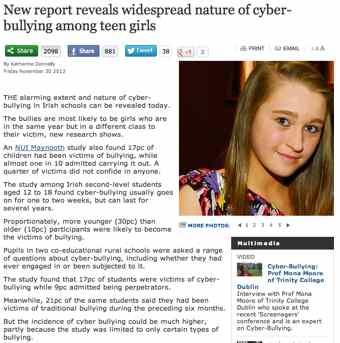
A study undertaken by two Maynooth University psychologists, Padraig Cotter and Dr Sinéad McGilloway, attracted significant media attention in recent days in the wake of three high profile teen suicides, all of which have been linked to cyberbullying. The report published recently in the Irish Journal of Education and featured (amongst others) on the front page of the Irish Independent and in the Irish Examiner, as well as numerous radio stations, was the first undertaken in Ireland (and, at the time of the study, one of the few in Europe) to assess the nature and extent of cyberbullying/e-bullying in a sample of schoolchildren aged 12-18 years.

The results showed that 17% of participants had been cyberbullied whilst almost one in ten admitted to being perpetrators. Approximately one in five reported that they had been victims of traditional bullying, although participants regarded cyberbullying to be much worse. The rates of cyber-bullying were generally lower than in other countries, but the study did not include chatrooms, instant messaging or social networking sites which have recently seen a huge growth in popularity. When asked about the findings, Dr McGilloway, Director of the Mental Health and Social Care Research Unit, commented “It is likely that, if the study were to be repeated today and all categories of cyberbullying were taken into account, the overall victimisation and perpetration rates would be higher and more comparable to other countries. Whilst further research in this area is needed, these preliminary results suggest that cyberbullying is an issue of considerable concern which needs to be tackled by parents, teachers/schools, young people and policy makers alike”. A copy of the paper may be obtained from Dr McGilloway (contact here).
Further work on cyberbullying amongst a young LGBTQI sample is currently underway in the Department of Psychology.
Read a sample media story here.
Read the Original Research Article here.
